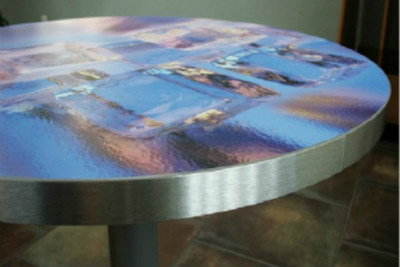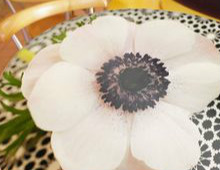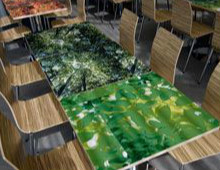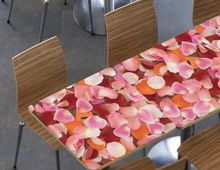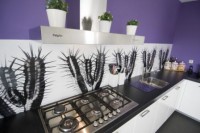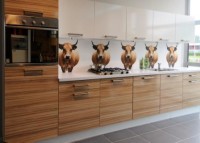HPL Table(tabletop)
Table tops are HPL normally in woodgrain or solid color with decorative stickers,which is easy to rip off. With digital print system, pattern could be printed on HPL directly,being time-saving, neaty,anti-scratch and weigh load up to 300 pounds. It is highly recommended in some high-end restaurant/hotel or studios.
Suggest : HPL bonded board
HPL Countertop(laminate counter)
HPL is usually applied as countertop material in high-end kitchen or washroom.HPL material
features its light- weight being solid and anti-compact at the same time.
For example, a marble designs HPL could replace real quartz countertop,being cost -effective and long-term use.
Nomarlly, a HPL laminate would be postformed with 90 angles to creat horizontal and vertical splackback with seamless edge, being water-impervious.It is easy to clean and do maintenance work.
suggest: HPL bonded board
Shape profile: round/elliptical/square/rectangular or any shape you required.
common thickness:0.4″/0.47″/0.6″/0.7″
1) How to clean HPL tabletop?
Table tops can be wiped with a soft, damp cloth. Stains can be removed with warm soapy water or with a standard cleansing agent.Stubborn stains can generally be removed with organic solvents.
2)Could tabletop shape being customized?
Yes, tabletop shape could be customized by clients ,and completed by CNC milling machine
3)What are the 2 main categories of countertop laminate?
· Flat laminate countertop.It consists of horizontal laminate surface and vertical laminate surface ( or pvc edge banding) ,but with a variety of custom “nosings” available. Flat laminates may be used for a variety of geometrically angled and shaped countertops, islands, eating bars, desk tops, etc.
·Postform Countertop.It refers to horizontal surface where laminate may be heated and rolled over substrate to create a seamless edge and splashback together.These rolls may be formed in only one direction, leading to long, directional pieces called “countertop blanks”.
The typical minimum radii of edge corners would be 1/4″ (6.4 mm) inside radius-surface and 3/8″ (9.5 mm) outside radius-surface
Note: when edge banding, it is recommended that the laminate extend at least 3″ (76.2 mm) beyond the radius edge.

